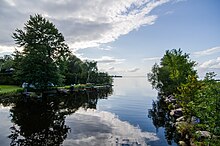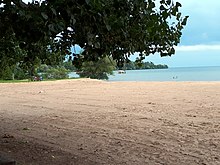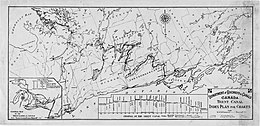Lake Simcoe
| Lake Simcoe | |
|---|---|
 Satellite view of Lake Simcoe andLake Couchichingdirectly north of it | |
| Location | Ontario |
| Coordinates | 44°26′12″N079°20′21″W/ 44.43667°N 79.33917°W |
| Type | Freshwater |
| Etymology | Named for Captain John Simcoe,RN |
| Primary inflows | Holland River,Talbot River |
| Primary outflows | Severn River |
| Catchment area | 2,840 km2(1,100 sq mi)[1] |
| Basincountries | Canada |
| Max. length | 30 km (19 mi)[2] |
| Max. width | 25 km (16 mi)[2] |
| Surface area | 722 km2(279 sq mi)[3] |
| Average depth | 15 m (49 ft)[4] |
| Max. depth | 41 m (135 ft)[2] |
| Water volume | 11.6 km3(2.8 cu mi)[1] |
| Shore length1 | 240 kilometres (150 mi)[4] |
| Surface elevation | 219 m (719 ft)[5] |
| Islands | Georgina Island,Thorah Island,Strawberry Island,Snake Island,Fox Island,Helmers Island,Grape Island |
| Settlements | Orillia,Barrie |
| References | [citation needed] |
| 1Shore length isnot a well-defined measure. | |
Lake Simcoeis a lake in southernOntario,Canada, the fourth-largest lake wholly in the province, afterLake Nipigon,Lac Seul,andLake Nipissing.[6]At the time of the first European contact in the 17th century, the lake was calledOuentironk( "Beautiful Water" ) by the native Wendat/Ouendat (Huron) people. It was also known asLake Tarontountil it was renamed byJohn Graves Simcoe,the firstLieutenant-Governor of Upper Canada,in memory of his father, Captain John Simcoe of the Royal Navy. InAnishinaabemowin,the historical language of the First Nations living around this lake, namely Anishinaabek ofRamaandGeorgina IslandFirst Nations, the lake is calledZhooniyaang-zaaga'igan,meaning "Silver Lake".[7]
Toponymy[edit]
Lake Simcoe's name was given byJohn Graves Simcoein 1793 in memory of his father, Captain John Simcoe. Captain Simcoe was born on 28 November 1710, inStaindrop,inCounty Durham,northeast England, and served as an officer in theRoyal Navy,dying of pneumonia aboard his ship,HMSPembroke,on 15 May 1759.[8]
Historically, at the time of the first European contact in the 17th century, the lake was calledOuentironk( "Beautiful Water" ) by theWyandot(Huron) natives; The Wyandot name for the lake was rendered asWentaronin European sources up until the 20th century.[9][10] A 1675 map byPierre Raffeixreferred to the lake with the French termLac Taronto[11]and a 1687 map byLahontancalled itLake Taronto,while the nameTarontos Lacappeared on a 1678 map ofNew Franceby cartographerJean-Baptiste-Louis Franquelin.[12]The term Taranto refers to anIroquoianexpression meaning gateway or pass. Taronto had originally referred to The Narrows, a channel of water through which Lake Simcoe discharges intoLake Couchiching.(Natural Resources Canada gives a related translation: "it originated as the Mohawk phrase tkaronto, which means" where there are trees standing in the water ". According to several Mohawk speakers and aboriginal language expert John Steckley.[clarification needed]Mohawks used the phrase to describe The Narrows, where Hurons and other natives drove stakes into the water to create fish weirs. Since then, many subsequent mapmakers adopted this name for it, thoughcartographerVincenzo Coronelliis thought to have introduced the more commonly used spelling ofTorontoin a map he created in 1695.[13]
The name 'Toronto' found its way to the current city through its use in the name for theToronto Carrying-Place Trail(or Toronto Passage), aportagerunning betweenLake OntarioandGeorgian Bay,that passed through Lake Toronto, which in turn was used as the name for an early French fort located at the foot of the Toronto Passage, on Lake Ontario. TheSevern River,its outlet stream, was once called 'Rivière de Toronto' which flows into Georgian Bay's Severn Sound, then called the 'Baie de Toronto'.
Later French traders referred to it asLac aux Claies,meaning "Lake of Grids (or Trellises)" in reference to the Huronfishing weirsin the lake. It was known by this name until the beginnings of Upper Canada, when it was renamed to Lake Simcoe.[14]
Geography[edit]

The lake is bordered bySimcoe County,Durham Region,andYork Region.The city ofBarrieis located onKempenfelt Bay,andOrilliais located at the entrance toLake Couchiching.The watershed draining into the lake contains a population of roughly half a million people, including the northern portion of theGreater Toronto Area(GTA).
The town ofGeorginalies along the entire south shore of Lake Simcoe and consists of smaller residential towns and communities, includingKeswickonCook's Bay,Sutton,Jackson's Point,Pefferlaw,andUdora.
The town ofInnisfiloccupies the western shore south of Barrie and north of Bradford. Eastside Simcoe includes the towns of Beaverton, Brechin and Lagoon City.
Lake Couchichingwas at one time thought of as a third bay of Simcoe, known as the Bristol Channel; however, the narrows between the two bodies of water separate them enough to consider this to be another lake. The narrows, known as "where trees stand in the water", an interpretation of the word 'Toronto', was an important fishing point for theFirst Nationspeoples who lived in the area, and theMohawktermtoran-teneventually gave its name toTorontoby way of the portage route running south from that point, the Toronto Carrying-Place Trail. Radiocarbon dating of surviving stakes reveals that the weirs at The Narrows were in use more than 4,000 years ago. The meaning of "where trees stand in the water", is likely to have originated from Huron practice of driving stakes into the channel sediments to corral fish. Fresh-cut saplings placed in the water and sediments would have sprouted branches and leaves, persisting for some time, leading to a place "where trees stand in the water".
Islands[edit]

Lake Simcoe contains a large island, Georgina, which along with Snake Island and Fox Island forms thereserveof theChippewas of Georgina Island First Nation.The lake is dotted with several smaller islands, includingThorah Island(a cottage destination),Strawberry Island,Snake Island, Helmers Island and Fox Island.Pope John Paul IIstayed on Strawberry Island for four days just beforeWorld Youth Day 2002in Toronto.[15]
Before the completion of theTrent Severn Waterway,the water level on Lake Simcoe was quite low enabling residents to cross in wagons or walk in ankle deep water to the mainland. However, when it was completed, the water table increased by several feet.Grape Islandon the north end the lake is located off of Orillia. To the east of Grape Island isGoffatt Island,a small and private island located withinRamara.[16]
Georgina, Snake and Fox Islands are withinYork Region,Thorah is withinDurham Region,where as Strawberry Island and Helmers Island are privately owned but within the boundaries ofRamarainSimcoe County.Grape is withinOrilliaand Goffatt is withinRamarawith both owned privately by residents.
Geology[edit]
The lake is about 30 kilometres (19 mi) long, 25 kilometres (16 mi) wide and 722 square kilometres (279 sq mi) in area.[2]Lake Simcoe is a remnant of a much bigger,prehistoriclake known asLake Algonquin.This lake's basin also includedLake Huron,Lake Michigan,Lake Superior,Lake Nipigon,andLake Nipissing.The melting of an ice dam at the close of thelast ice agegreatly reduced water levels in the region, leaving the lakes of today.
The lake is located onPaleozoiclimestone of the Ordovician period. However, due to deep deposits of glacial sediments, this bedrock only appears exposed along the lakeshore on Georgina Island. This rock, however, also appears along the shore of Lake Couchiching, where sediments are thinner. The outlet of the lake at the north end of Lake Couchiching is controlled by Precambrian bedrock which first makes its appearance about mid-way along this lake. As a result, the lake has persisted to the present, with the outlet-flow unable to cut down through the rock, and thereby draining the lake. This is unlike its one-time smaller sister-lake of 'Lake Minesing' to the west, being a remnant of Lake Algonquin, and, later the Nipissing stage of Lake Huron. This lake's outlet was founded on sediments located near Edenvale, which have largely been cut through, draining most of the lake. Today 'Lake Minesing' exists as the Minesing Swamp, but it re-establishes itself for a short period each spring when spring run-off floods the basin.
Isostatic rebound from the retreat of the last glaciers results in a steady rise of Lake Simcoe, particularly at its south end, and is further responsible for the deep organic sediments that have accumulated in its one-time shallow southern arm, known as the Holland Marsh. Here, organic deposits created by vegetation have largely kept pace with the steady rise in water level, and today supports extensive market gardening. All rivers, and most streams, flowing into the lake have wide, deep, navigable mouths as a consequence of the rising waters drowning the river channels.
2017 data for the year prior from theNOAAshows the lake has a yearly average surface temperature of 2.5degrees Celsius.[17]
Ecology[edit]

When a lake is healthy, cold-water fish such as lake trout, herring, and whitefish are abundant and active.[18]It is sometimes known as Canada'sice fishingcapital.
Ecological issues[edit]
Lake Simcoe has been victim to significanteutrophication.Lake Simcoe has seen a dramatic decline in some fish species, along with an increase in algae blooms and aquatic weed growth.Phosphorusemissions from both urban and rural sources have upset the lake's ecosystem and fostered excessive aquatic plant growth, raising water temperatures, and decreasing oxygen levels, thereby rendering limited breeding grounds inhospitable.
Lake Simcoe has been victim tozebra mussel,purple loosestrife,black crappie,spiny water flea,round goby,rusty crayfishandEurasian milfoilinvasions.[18][19][20][21]
The zebra mussel, which arrived in North American waters in 1985, originated in theBlack SeaandCaspian Seaarea and is thought to have been brought to North America in the ballast of foreign freighters. Zebra mussels are particularly harmful to Lake Simcoe because they increase the clarity of the water allowing sunlight to penetrate to the bottom of the lake, where more algae and aquatic weeds can grow, accelerating the eutrophication process.[18]
TheRainbow Smeltare another introduced species and they were first observed in the early 1960s. They were believed to compete with nativeLake Whitefishand be somewhat responsible for a decline in their populations.[20]
Several initiatives, such as the Lake Simcoe Environmental Management Strategy (LSEMS), the Lake Simcoe Conservation Foundation, and theLake Simcoe Region Conservation Authority,are making efforts to rectify some of the lake's environmental woes. A local activist group,The Ladies of the Lake,are using the $250,000 they raised from the sale of a nude picture calendar to rally government, business, the school system, and the local citizenry to rescue the lake. Several towns and communities on the lakeshore depend on Lake Simcoe for their drinking water.
The Region of York is currently finalizing plans for a sewage treatment plant to be constructed on the shores of Lake Simcoe[22]to be located on the Holland River in Cook's Bay. This plant's purpose is to support intensification of development in the Lake Simcoe watershed.
Watershed[edit]
A number of southern Ontario rivers flow, generally north, into the lake, draining 2,581 km2(997 sq mi) of land. From the east, theTalbot River,part of theTrent–Severn Waterway,is the most important river draining into Lake Simcoe, connecting the lake with theKawartha lakessystem and Lake Ontario. From its connection to Lake Couchiching, the Severn River is the only drainage from the lake to Georgian Bay, part ofLake Huron(Simcoe itself is not one of theGreat Lakes). Thecanal locksof the Trent-Severn Waterway make this connectionnavigable.

A number of creeks and rivers flow into the lake:
- Black River
- Bluffs Creek
- Beaver River
- Holland River
- Maskinonge River
- Pefferlaw River
- Talbot River
- White's Creek
- Duclos Creek
- Burnie Creek
- Virginia CreekA
- Virginia CreekB
- Virginia CreekC
- Virginia CreekD
Recreation[edit]

The lake has little commercial activity, but sees many recreational uses. In the winter, it freezes over completely and hosts a number of ice fishing competitions, making it one of the most intensely fished lakes in Ontario. However, claims that it is one of the world's largest lakes that freeze over completely in winter are pure speculation, and, in fact, spurious; Canada alone has a large number of lakes of the same size or larger that do the same.
In the summer, fishing is still an attraction; however, there are also a number of poker runs, jet-skiing, and other boating events. The lake is surrounded with summer cottages leading to heavy recreational and boating use in summer.
There are a number of beaches which attract visitors from the greater Toronto area, as Lake Simcoe has a reputation for cleaner and warmer water than nearby Lake Ontario beaches. Many of the beaches are used for kite surfing as well. Willow Beach in Georgina on the south shore is one of the largest and most popular public beaches on Lake Simcoe.
There are seven yacht clubs (sailing) around the lake, which host a number of regattas, and an active sailing community exists on the lake.

The lake also forms part of theTrent–Severn Waterwaysystem that links Lake Ontario and Georgian Bay/Lake Huron.
Lake Simcoe is also well known for its scuba diving. The shipJ. C. Morrisonsank in 1857 and is a great dive site off Centennial Beach. There are also a number of other popular scuba diving entrance points popular among fresh water divers. Kempenfelt Bay is the most popular for scuba divers as it is the deepest. Visibility ranges from over 30 feet to almost zero.
Maritime enforcement[edit]
Ontario Provincial Police,South Simcoe Police Service,York Regional Police,Durham Regional Police,andBarrie Policehave marine units that patrol on the waters of the lake.Georgina Island Policepatrol on Georgina, Fox and Snake Islands with some capability to respond to marine needs off these islands.[23]As part of Orillia,Grape Islandis policed by the OPP.
References[edit]
- ^ab"Lake Simcoe".World Lake Database.International Lake Environment Committee Foundation (ILEC). 1999. Archived fromthe originalon 18 December 2014.Retrieved18 December2014.
- ^abcdGuan, Xian (2009)."Monitoring Lake Simcoe Water Quality using Landsat TM Images"(PDF).uwspace.uwaterloo.ca.University of Waterloo. p. 24.Retrieved18 December2014.
- ^"Lake Simcoe".Corporation of the Town of Georgina Official Website.Town of Georgina. 2014. Archived fromthe originalon 15 August 2013.Retrieved17 December2014.
- ^ab"Lake Simcoe Region Authority A Watershed For Life".Lake Simcoe Region Conservation Authority. 2014. Archived fromthe originalon 26 December 2014.Retrieved18 December2014.
- ^"National Data Buoy Center".National Oceanic and Atmospheric Administration's National Data Buoy Center.U.S. Dept. of Commerce. 1 October 2014.Retrieved18 December2014.
- ^"Ontario – Lake Areas and Elevation".Lakes.Atlas of Canada.Archived fromthe originalon 10 April 2007.Retrieved15 March2010.
- ^Grait Lakes Waterfront Trail Brochure
- ^Rayburn, Alan.Place Names in Ontario.University of Toronto Press. p. 184.
- ^Reclus, Elisée (1893).The Earth and Its Inhabitants Volume 15, pt. 1; British North America.Vol. 15. London: D. Appleton. p. 252.ISBN978-1236399823.
- ^Bradshaw, W. R. (July–December 1900)."Romantic Muskoka".The Anglo-American Magazine.Vol. 4. The Anglo-American Publishing Company. p. 59.
- ^Timothy B. Leduc (May 2016).Canadian Climate of Mind: Passages from Fur to Energy and BeyondII.McGill-Queens. p. 53.ISBN9780773547629.Retrieved15 October2018.
- ^Seputis, Jasmin (14 October 2018)."'Tarontos Lac': Geographer finds oldest known reference to Toronto on 340-year-old French map ".Retrieved14 October2018.
- ^"The real story of how Toronto got its name".Natural Resources Canada.Archived fromthe originalon 9 December 2011.Retrieved17 April2006.
- ^Quayle Innis, Mary, ed. (2007).Mrs. Simcoe's Diary.Dundurn Press.ISBN978-1-55002-768-6.
- ^John Paul to rest as cross makes way through Toronto
- ^"Goffatt Island – Ontario, Canada – Private Islands".
- ^"NOAA View Global Data".NOAA Global Data Viewer.NOAA. 2017.Retrieved7 September2017.
can be determined by moving the mouse over the area of the lake
- ^abc"Addressing The Issue".Archived fromthe originalon 3 December 2008.Retrieved7 August2009.
- ^Walker, Susan (3 March 2007)."Lake Simcoe 'Ladies' to the rescue".The Star.Toronto.Retrieved7 August2009.
- ^ab"Invasive Species".Archived fromthe originalon 3 December 2008.Retrieved7 August2009.
- ^nurun.com."Invasive crayfish a plenty".orilliapacket.com.Retrieved18 January2017.
- ^"UYSSolutions Information – UYSSolutions".uyssolutions.ca.Retrieved18 January2017.
- ^"Fire & Police Services | Georgina Island".
Bibliography[edit]
- "State of the Lake Simcoe Watershed 2003".Lake Simcoe Region Conservation Authority.Archived fromthe originalon 8 April 2005.Retrieved17 February2010.

